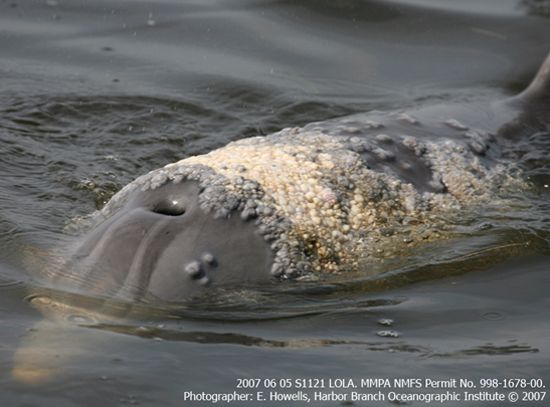abstract
Lobomycosis (lacaziosis) is a chronic granulomatous disease of the skin and subcutaneous tissue that occurs only in dolphins and humans under natural conditions.3,5 The etiologic agent, Lacazia loboi, is found abundantly within lesions, appearing as yeast-like organisms, 6 to 12 um in diameter with thick, refractile walls, arranged singly or in chains connected by tube-like bridges.1,3 Recently, an antigenic relationship between Lacazia in dolphins and humans was shown by western blot analyses of sera.2 The clinical and pathological manifestations of lobomycosis in humans and dolphins are similar and consist of cutaneous nodules that progress slowly over the course of years without involvement of internal organs or mucous membranes.4 The tissue response consists of multifocal, subepidermal granulomas with inflammatory infiltrates containing histiocytes, multinucleated giant cells and large numbers of yeast-like cells.1
In bottlenose dolphins (Tursiops truncatus), lesions are found on the leading edges of the dorsal and pectoral fins, the head, fluke and caudal peduncle where they form multiple aggregations of firm, white raised nodules that may extend > 30 cm in the broadest dimension (Figure 1). Local trauma appears to create a portal of entry for the organism in both species.4,5 Lobomycosis in bottlenose dolphins was first identified along the Gulf and Atlantic coasts of Florida in the 1970's. Recently, we found that the prevalence of lobomycosis in bottlenose dolphins in the Indian River Lagoon (IRL), Florida is approximately 10 percent.4 In humans, the disease is endemic in South and Central America. It has not been reported from Florida.
We evaluated immune status in eight dolphins with lobomycosis and 42 healthy dolphins sampled in the IRL between 2003 and 2005. Methods for evaluating innate and adaptive immunity have been described previously.6 Lobomycosis cases had multiple abnormalities in immunologic parameters when compared to healthy dolphins. The absolute number of circulating lymphocytes and serum albumin concentration were reduced (p<0.05); segmented neutrophils, alpha 1, total beta, total gamma and total globulins were increased (p<0.05). Innate immunity was relatively intact; phagocytosis and natural killer cell activity were not affected but plasma lysozyme concentrations, a marker for pro-inflammatory antibacterial activity, were elevated in dolphins with lobomycosis (p<0.05). Adaptive immunity was depressed; statistically significant decreases were found in the absolute numbers of CD4+ helper T cells and CD19+ and CD21+ B cells. The ratios of CD2+ T cells to CD4+ cells and CD2+ to CD21+ cells were increased (p< 0.05) and the numbers of lymphocytes expressing MHC class II molecules was decreased in dolphins with lobomycosis (p<0.05). Lymphocyte proliferation was reduced in response to stimulation with lipopolysaccharide and concanavalin A (p<0.05). Antibody responses to Erysipelas rhusiopathiae, a common marine micro-organism, were decreased (p<0.05). In summary, dolphins with lobomycosis exhibit significant impairment in adaptive immunity. These immune alterations may reflect the host response to infection with L. Loboi. Alternatively, acquired immunodeficiency, potentially due to exposure to environmental contaminants, may have rendered dolphins susceptible to infection and progressive disease.
| Figure 1. | 
Photograph of a dolphin with lobomycosis from the Indian River Lagoon, FL. Photograph courtesy of E. Howells, Harbor Branch Oceanographic Institution, 2007. |
|
| |
acknowledgements
This work was conducted under National Marine Fisheries Service Permit No. 998-1678-01, issued to Dr. Gregory Bossart in March 2003. Supported by Harbor Branch Oceanographic Institution's "Florida Protect Wild Dolphins" program and NOAA Fisheries Marine Mammal Health and Stranding Response Program.
References
1. Bossart GD. 1984. Suspected acquired immunodeficiency in an Atlantic bottlenose dolphin with chronic-active hepatitis and lobomycosis. J Am Vet Med Assoc 185: 1413-1415.
2. Mendoza L, Belone AFF, Vilela R, Rehtanz M, Bossart GD, Reif JS, Fair PA, Durden WN, St Leger J, Travassos LR, Rosa PS. 2008. Use of sera from humans and dolphins with lacaziosis and sera from experimentally infected mice for Western Blot analyses of Lacazia loboi antigens. Clinical and Vaccine Immunol 15:164-7.
3. Migaki G, Valerio MG, Irvine B, Garner FM. 1971Lobo's disease in an Atlantic bottlenose dolphin. J Am Vet Med Assoc 159: 578-82.
4. Reif JS, Mazzoil M, McCulloch SD, Varela RA, Goldstein JD, Fair PA, Bossart GD. 2006. Lobomycosis in Atlantic bottlenose dolphins (Tursiops truncatus) from the Indian River Lagoon, Florida. J Am Vet Med Assoc 228: 104-108.
5. Rodriguez-Toro G. 1993. Lobomycosis. Int J Dermatol 32: 324-332.
6. Romano T, Fair PA, Bossart GD, Rice C, Peden-Adams A. 2005. An overview of immune assessment in bottlenose dolphins during capture-release studies from the HERA project. Proceedings of Workshop "Health Assessment of Bottlenose Dolphins in the Indian River Lagoon, Florida and Charleston, South Carolina.
7. Bossart GD, Fair PA (editors), 16th Biennial Conference on the Biology of Marine Mammals. San Diego, CA. pp 27-29.